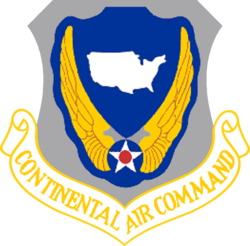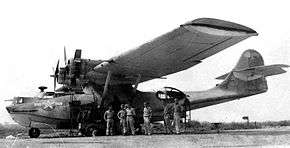310th Air Division
The 310th Air Division is an inactive United States Air Force organization. Its last assignment was with Continental Air Command 's Twelfth Air Force at Tinker Air Force Base, Oklahoma, where it was inactivated on 27 June 1949.
310th Air Division
 | |
|---|---|
 OA-10 Catalina as flown by the 3d Emergency Rescue Squadron | |
| Active | 1944–1946; 1947–1949 |
| Country | |
| Branch | |
| Role | Command of reserve forces |
| Part of | Continental Air Command |
| Engagements | South West Pacific Theater of World War II |
| Decorations | Philippine Presidential Unit Citation |
The division was first activated as the 310th Bombardment Wing in New Guinea during World War II. It served as a task force headquarters, commanding advanced elements of Fifth Air Force during the New Guinea campaign and the liberation of the Philippines. After VJ Day, it moved to Japan, serving in the occupation forces until inactivating in March 1946. The wing was again activated in the reserves in 1947, becoming a division the following year.
History
World War II
During World War II, the 310 Bombardment Wing, Medium was a command echelon of Fifth Air Force in the Southwest Pacific theater, controlling numerous fighter and bomber groups and squadrons until the Japanese surrender in 1945. Its attached units "flew missions against Japanese shipping, coastal installations, gun positions, airdromes, and troop concentrations. Fighting in New Guinea and later in the Philippine Islands, attached fighter units flew escort for bombing, supply, and reconnaissance missions."[1] In October 1945, the wing moved to Japan and served in the occupation force. It was inactivated in Japan during early 1946.[1]
Air Force Reserve
The 310th Bombardment Wing was activated as a reserve unit under Air Defense Command (ADC) at Tinker Field, Oklahoma on 26 July 1947, but had no units assigned until September when the 323d Bombardment Group was activated at Tinker and assigned to the wing. The 177th AAF Base Unit (later the 2592d Air Force Reserve Training Center) supervised the training of reserve units at Tinker.[2][3] Later that fall, at the end of October, the 340th Bombardment Group was activated at Tulsa Municipal Airport and assigned to the wing.[1] Although the units were designated as bombardment units, it appeared they were equipped with North American AT-6 Texan and Beechcraft AT-11 aircraft only.[4]
In 1948, when the regular Air Force implemented the wing base organization system, the wing, along with other multi-base reserve wings was redesignated as an air division.[1] The same year, Continental Air Command assumed responsibility for managing reserve and Air National Guard units from ADC.[5]
The 310th was inactivated when Continental Air Command reorganized its reserve units under the wing base organization system in June 1949.[1] The division's personnel and equipment were transferred to the 323d Bombardment Wing, which was activated at Tinker the same day and assumed command of the 323d Bombardment Group.[6] President Truman’s reduced 1949 defense budget also required reductions in the number of units in the Air Force,[7] and the 340th Group was inactivated in August and not replaced as reserve flying operations at Tulsa ceased.[8]
Lineage
- Established as the 310th Bombardment Wing, Medium on 20 January 1944
- Activated on 1 February 1944
- Inactivated on 25 March 1946
- Redesignated 310th Bombardment Wing, Light on 27 May 1947
- Activated in the Reserve on 26 July 1947
- Redesignated 310th Air Division, Bombardment on 16 April 1948
- Inactivated on 27 June 1949[1]
Assignments
- Fifth Air Force, 1 February 1944 – 25 March 1946
- Tenth Air Force, 26 July 1947
- Fourteenth Air Force, 1 July 1948
- Twelfth Air Force, 12 January – 27 June 1949[1]
Stations
- Gusap Airfield, New Guinea, 1 February 1944
- Hollandia, New Guinea, 6 May 1944
- Wama Drome, Morotai, Netherlands East Indies, 18 September 1944
- Bayug Airfield, Leyte, Philippines, 14 November 1944
- McGuire Field, Mindoro, Philippines, 15 December 1944
- Clark Field, Luzon, Philippines, 23 August 1945
- Itami Airfield, Japan, 21 October 1945 – 25 March 1946
- Tinker Field (later Tinker Air Force Base), Oklahoma, 26 July 1947 – 27 June 1949[1]
Components
World War II
- Groups
- 3d Bombardment Group: attached 1 May 1944 – September 1944; 15 January 1945 – 31 May 1946[9]
- 8th Fighter Group: attached c. 31 May 1944 – c. 25 March 1946[1][10]
- 18th Fighter Group: attached 24 March – 26 April 1945[11]
- 35th Fighter Group: attached 1 February – 1 August 1944, 2 October 1944 – 25 March 1946[12]
- 38th Bombardment Group: 19 October 1944 – c. 25 March 1946[1]
- 42d Bombardment Group: attached 3–14 September 1944, assigned 31 January – 25 March 1946[13]
- 49th Fighter Group: attached 1 February – 1 May 1944, 9 January – 29 May 1945, 25 September – 10 November 1945[14]
- 58th Fighter Group: attached 9 January – 7 April 1945[1]
- 71st Tactical Reconnaissance Group: attached 9 January – 10 November 1945[1]
- 90th Bombardment Group: attached 31 May – 3 September 1944; 15 January – 23 November 1945[1]
- 312th Bombardment Group: 31 May – 3 September 1944; 1 July – 13 October 1945
- 348th Fighter Group: 1 May – 25 August 1944; 25 September 1945 – 25 March 1946
- 375th Troop Carrier Group: 24 March – 9 August 1945
- 380th Bombardment Group: c. 24 March 1945 – unknown
- 417th Bombardment Group: 9 January – 1 November 1945
- 475th Fighter Group: 14 May – 16 June 1944[1]
- Squadrons
- 3d Emergency Rescue Squadron: 9 January 1945 – unknown
- 17th Photographic Reconnaissance Squadron: 29 May – 3 September 1944; c. 24 March – 3 April 1945
- 25th Liaison Squadron: c. 15 January 1945 – unknown
- 25th Photographic Reconnaissance Squadron: c. 9 January 1945 – unknown
- 26th Photographic Reconnaissance Squadron: c. 1 July – 3 September 1944
- 41st Troop Carrier Squadron: c. 17 May – 3 September 1944
- 65th Troop Carrier Squadron: c. 15 January 1945 – unknown
- 66th Troop Carrier Squadron: c. 15 January 1945 – unknown
- 82d Tactical Reconnaissance Squadron: 9 January 1945 – unknown
- 110th Reconnaissance Squadron (later 110th Tactical Reconnaissance Squadron): c. 1 February – 10 April 1944; c. 9 January 1945 – unknown
- 318th Troop Carrier Squadron: c. 15 January 1945 – unknown
- 418th Night Fighter Squadron: 15 May – 9 November 1944; 26 December 1944 – 30 January 1945; 22 October – 10 November 1945
- 421st Night Fighter Squadron: c. 31 May – 3 September 1944
- 547th Night Fighter Squadron: 9 January 1945 – unknown; 22 October – 10 November 1945[1]
Air Force Reserve
- 323d Bombardment Group: 9 September 1947 – 27 June 1949
- 340th Bombardment Group; 31 October 1947 – 19 August 1949[15]
Aircraft
- Douglas A-20 Havoc, 1944-c. 1945
- Douglas A-26 Invader, 1944-c. 1945
- Consolidated B-24 Liberator, 1944-c. 1945
- North American B-25 Mitchell, 1944-c. 1945
- Beechcraft C-43 Traveler, 1944-c. 1945
- Beechcraft C-45 Expeditor, 1944-c. 1945
- Lockheed F-5 Lightning, 1944-c. 1945
- Stinson L-5 Sentinel, 1944-c. 1946
- Lockheed P-38 Lightning, 1944-c. 1945
- Bell P-39 Airacobra, 1944-c. 1945
- Curtiss P-40 Warhawk, 1944-c. 1945
- Republic P-47 Thunderbolt, 1944-c. 1945
- Northrop P-61 Black Widow, 1944-c. 1945
- Douglas P-70 Havoc, 1944-c. 1945
- Curtiss C-46 Commando, c. 1945-c. 1946
- Douglas C-47 Skytrain, c. 1945-c. 1946
- Consolidated OA-10 Catalina, c. 1945-c. 1946
- North American P-51 Mustang, c. 1945-c. 1946.
Commanders
References
Notes
- "Factsheet 310 Air Division, Bombardment". Air Force Historical Research Agency. 5 October 2007. Archived from the original on 24 October 2012. Retrieved 26 March 2014.
- Mueller, p. 549
- "Abstract, History 10 Air Force Jul–Sep 1947". Air Force History Index. Retrieved 14 May 2016. (histories of Tenth Air Force reserve training centers)
- See "Abstract, History 340 Bombardment Group Apr–Aug 1948". Air Force History Index. Retrieved 14 May 2016.
- "Abstract, Mission Project Closeup, Continental Air Command". Air Force History Index. 27 December 1961. Retrieved 24 March 2014.
- Ravenstein, pp. 174–176
- Knaack, p. 25
- Maurer, Combat Units, pp. 218–219
- Robertson, Patsy (6 February 2015). "Factsheet 3 Operations Group (PACAF)". Air Force Historical Research Agency. Archived from the original on 4 June 2016. Retrieved 10 May 2016.
- Robertson, Patsy (6 February 2015). "Factsheet 8 Operations Group (PACAF)". Air Force Historical Research Agency. Archived from the original on 3 March 2016. Retrieved 10 May 2016. indicates the 8th Group was attached to the 86th Fighter Wing until 16 August 1945.
- Robertson, Patsy (2 April 2014). "Factsheet 18 Operations Group (PACAF)". Air Force Historical Research Agency. Archived from the original on 4 June 2016. Retrieved 10 May 2016.
- Robertson, Patsy (13 May 2008). "Factsheet 35 Operations Group (PACAF)". Air Force Historical Research Agency. Retrieved 10 May 2016.
- Robertson, Patsy (6 February 2015). "Factsheet 42 Air Base Wing (AETC)". Air Force Historical Research Agency. Archived from the original on 5 June 2016. Retrieved 6 October 2016.
- Kane, Robert B. (22 September 2010). "Factsheet 49 Operations Group (ACC)". Air Force Historical Research Agency. Retrieved 11 May 2016.
- Maurer, Combat Units, pp. 218–219, 419
- Commanders for the period the unit was assigned to the reserve are not known. Factsheet, 310 Air Division, Bombardment
Bibliography
![]()
- Maurer, Maurer, ed. (1983) [1961]. Air Force Combat Units of World War II (PDF) (reprint ed.). Washington, DC: Office of Air Force History. ISBN 0-912799-02-1. LCCN 61060979.
- Maurer, Maurer, ed. (1982) [1969]. Combat Squadrons of the Air Force, World War II (PDF) (reprint ed.). Washington, DC: Office of Air Force History. ISBN 0-405-12194-6. LCCN 70605402. OCLC 72556.
- Mueller, Robert (1989). Air Force Bases, Vol. I, Active Air Force Bases Within the United States of America on 17 September 1982 (PDF). Washington, DC: Office of Air Force History. ISBN 0-912799-53-6.
- Ravenstein, Charles A. (1984). Air Force Combat Wings, Lineage & Honors Histories 1947–1977. Washington, DC: Office of Air Force History. ISBN 0-912799-12-9.
.svg.png)